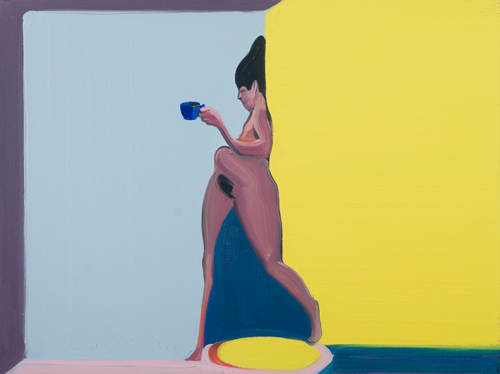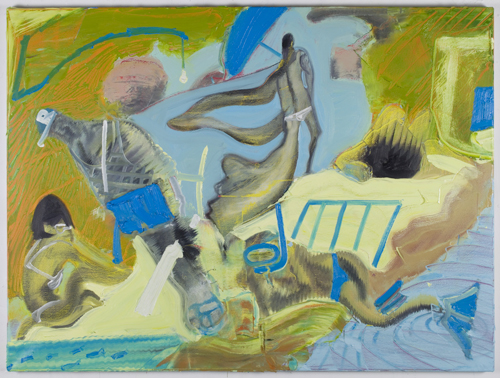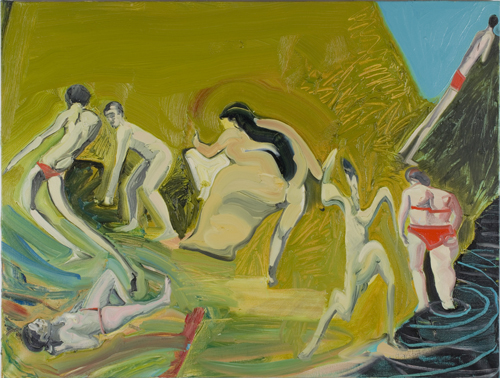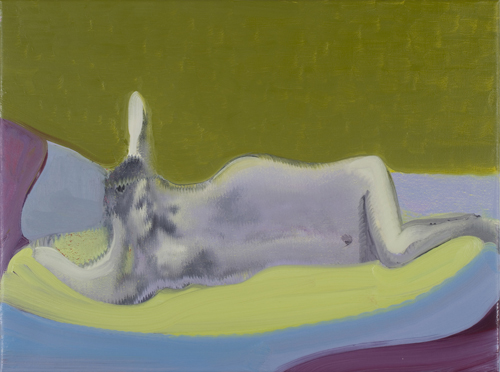
by JANET McKENZIE
Janet McKenzie: You used the exhibition you curated at the Jerwood Encounters Space in London as a means of questioning the narrative in contemporary painting. Can you explain how you came to choose Alfred Hitchcock’s romantic thriller Suspicion as your point of departure?
Dan Coombs: I wanted to use the opportunity to curate a show at Jerwood Space to try to answer a question I’ve been asking since I was a student, 20 years ago: what is narrative in painting? I hoped that the show would go a little way to clarifying the problem. Narrative in painting is laced with contradictions, because the narrative impulse is in conflict with the aesthetic impulse. Narrative has to be broken or suspended in order for the aesthetic connection to occur. I feel that Hitchcock’s narratives are intensified by vivid aesthetic moments that seem to pull his narratives out of time, so certain sequences seem to take on the condition of painting. The “glass of milk” sequence in Suspicion seemed to embody this – as well as being strange, uncanny and ambiguous, qualities I look for in painting.
JMcK: How did you choose the 13 artists for Suspicion, and what do you think they achieved as a group?
DC: I thought of the painters I knew whose work bore a relationship to the gothic or the uncanny, as well as to cinema and to narrative. I think the gothic sensibility runs very deep in British art, but is often buried. I also thought of particular images I had seen in the artists’ studios, and how the images might build up to create a narrative in the exhibition as a whole. In choosing the works, I was looking for contrast and disjunction, as much as continuity and congruity.
JMcK: Your choice of the Hitchcock film highlights the relationship between painting and cinema. One thinks of Edward Hopper in particular, and the sense of haunting stillness he achieved in paint. How can painting compete with the powerful drama of modern film?
DC: I think drama in painting is more internalised, more interior and suspended in time. John Stezaker, the artist whom I interviewed in the exhibition in its last week, put it very clearly in talking about his collages: “The work for me always takes off when something unexpected happens, and whatever it is I intended defies my intentions. I’m trying to allow for what is denied to us in cinema: formal apprehension. I want to see the picture as a whole, because that’s what you can never see in cinema: because you’re always absorbed into the next image, you never get a sense of seeing what it is as a whole.”
JMcK: Narrative was considered anathema in painting during the 1960s when the art critic Clement Greenberg’s formalism was in an ascendant position, and still very unfashionable in the 70s and 80s. How, as a student at the Ruskin, Oxford, and then at the Royal College of Art, London, did you feel about the domination of non-figurative art?
DC: The problem in painting is not one of quality, it is one of realness. Realness is quality, and this applies as much to abstract art as figurative art. Art isn’t grounded in taste as Greenberg thought; it is grounded in its reaching for the real. Painting is a highly artificial construct that lags far behind reality. At the Royal College, I was taken with the notion of Lacan that the real is not a given, but something held in tension by the symbolic and the imaginary. Realness in painting does not equal realism, and often realist paintings are the least real of all painting! Realness is something that has to be sought out and struggled towards, and without it painting becomes decorative or illustrational.

Daniel Coombs. La Plage, 2014. Oil on canvas, 120 x 90 cm. © the artist.
In surrealism, the real emerges out of contradiction and disjunction. In abstract expressionism, it’s in the actual material field of the painting. Myself, I can only reach the real through the imaginary, and I’ve often wondered why I can’t be more straightforward. Narrative is often set up in order to be broken, or to be suspended like a recurring dream. Dreams fascinate because we know the real is lurking behind them. I suppose for me the aesthetic is an intensified relationship with the real.
JMcK: You taught for seven years at the Ruskin and now are one of a small staff to have established a private school of art, where painting alone is taught. What do you hope to teach at Turps Banana Art School?
DC: We are hoping to teach how to get inside the medium of painting and how the student can make it their own. Painting requires diligence, discipline and a kind of stamina, a kind of rhythm that builds up over time. It also depends on internalisation, on absorption of forms, techniques and devices. It’s tough – it evolves through failure. Painters have to learn to lay down their ego, and give themselves over to the medium, to find their own voice within it. There is a kind of shock that comes through self-realisation, a release, a new freedom.
JMcK: How does Turps Banana differ from existing art schools in the UK?
DC: Turps Banana is based in a studio complex on the Aylesbury Estate in Camberwell, south-east London. There is no bureaucracy, just a studio and a team of painters who mentor the students. It is very direct in its approach, cheaper than an accredited course, and the students are already committed painters who wish to develop their practice. We have been able to attract some major artists to teach because they recognise its closeness to actual studio practice, and find the environment real, raw and stimulating.

Daniel Coombs. The Beach, 2013. Oil on canvas, 100 x 75 cm. © the artist.
JMcK: Which artists did you most admire or emulate when you were a student?
DC: I did the usual thing. I was interested in Willem de Kooning and Cy Twombly and tried to emulate their directness, and quickly found that their impact and velocity was impossible to match. My versions were like cartoons. My interest in Francis Bacon came later, after I had left college, when life became more complicated. I always loved Picasso and Matisse, and I still look to Matisse for formal guidance. I guess I was working through a lot of stuff, and there was nothing particularly unusual in whom I was looking at – though, now, the absence of women in the painting canon seems to stick out like a sore thumb.
JMcK: How did you consider your education at the Ruskin in the late 80s, with its emphasis on drawing and anatomy, existed within the art world at large?
DC: Life drawing, which I did a lot of as a student, was a liberation for me, because it puts you in relation to something that is more complex than anything you can hold in your imagination. The human body is sublime in that sense. I think it’s regrettable that life drawing is no longer widely practised in art school.
JMcK: Who are the artists you most admire now and who have exerted most influence on your development as an artist?
DC: Often I find myself responding to a sense of anxiety or vulnerability in art. I’m not quite sure why this is: it may be that it opens up a more felt-out space. I like sculpture – I was very interested in Eva Hesse for a long time, as well as Bruce Nauman and, recently, Rachel Harrison. I think all those artists give materials a kind of anxious quality, a sense of contradiction, tragedy even. I’m fascinated by photography, and respond to photographers who manage to capture the way people generate a kind of field around themselves; William Eggleston and Garry Winogrand never fail to draw me in. At the moment in painting, I can’t get enough of Frank Auerbach. His work probably has no relation to my own, which is maybe why I like it so much.

Daniel Coombs. Nude, 2014. Oil on canvas, 60 x 45 cm. © the artist.
JMcK: Can you explain your intentions in your recent series of Nudes?
DC: The Nudes are painted from photographs that are distorted by vibrating and shaking the image of the nude on a photocopier. I have to make hundreds, and from those choose ones to paint from. This random process generates figures that are both grotesque and beautiful, alien and familiar. They challenge the male gaze – they create new boundaries and obstacles to that imaginary visual mastery, and stretch and challenge my own sense of desire. In contemporary culture, male sexuality is formed in a large part through a relation to images. I wanted to change my relationship to those images. For me, new feelings and vulnerabilities are opened up through the distortions – distortions that are intensified through the act of painting.
JMcK: What does collage enable you to do that pure painting does not?
DC: The compositions of my paintings are developed through collage studies that I use to paint from. The figures are distorted or straight photocopies that I place, move and paint around on a smaller canvas. Collage enables me to hold the form of each figure, but to move them in relation to each other within a field space. It also brings in an element that exists outside of myself, that is found rather than invented. Creating everything from scratch seems ridiculous to me. The world is so complex that I can’t imagine having no relation to photography or the empirical. Though I invent environments and relationships around the figures, and the paintings intentionally blur the relation of the real and the imaginary, there has to be a tension. It seems impossible for me to work entirely from the imagination. To me that would be willfully naive.
• Jerwood Encounters: Suspicion, curated by Dan Coombs, was at Jerwood Visual Arts, London from 5 November – 7 December 2014.